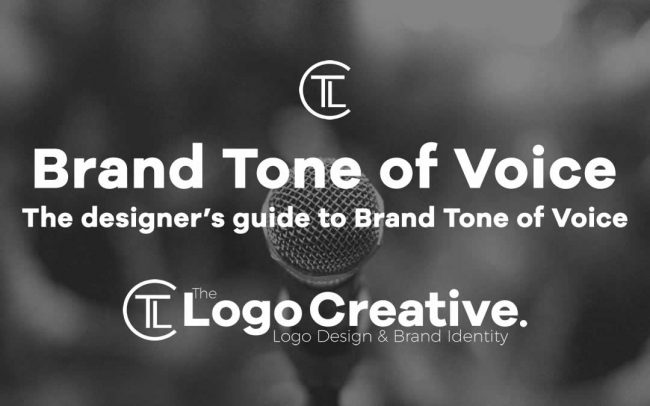Designers and Art Directors (the good ones at least) know how to handle words.
I know one excellent Graphic Designer who can’t spell for toffee, but he really gets how important words are in his design process. I’m not saying I’d trust him to craft a 5,000-word brochure or come up with the next ‘Just Do It’, but his headline ideas and creative rationale really bring everything to life. In this article, we discuss The designer’s guide to Brand Tone of Voice
Table of Contents
Everyone’s Talking About Tone of Voice
Tone of Voice (ToV) is a hot topic. There are loads of informative, but perhaps overly complicated articles online. Equally, there are a ton that just about scratch the surface.
This post is for anyone who needs to work with words, but isn’t a fully paid-up member of the Royal Guild of Copywriters. It’s a practical guide that should not only convince you of the power of defining a brand’s ToV, but will help you to bring words into play when tackling your next branding brief.
I won’t blind you with science (even if I could), but if you can spare 5 minutes, you’ll be left with a bit of inspiration and a few simple steps to add depth to your design approach.
Which comes first, the words or the design?
It’s tempting and logical to start the design process with mood boards. Photography, illustration, textures, colours, print finishes… all visually seductive. They help set a course for where the design might go, but what about ToV?
I’d argue that if you started with words instead of pictures, you would end up with a much more focused and powerful design approach.
Let’s imagine you’ve been tasked with re-branding a range of walking boots.
If you have a well-written brief, start by pulling out the juiciest, most salient words and phrases from the briefing document and laying them out big and bold.
Even if there isn’t a written brief – shame on the agency – look to the packaging, product inserts, care instructions, website…
For argument’s sake, you’ve harvested the following wordy nuggets:
Designed to handle the most rugged terrains / Waterproof / Comfortable / Tested in the Lake District / With the right care, they will last for years / Built for any weather / Light, but strong…
Straightaway, you have lots to work with.
Now let’s have some fun
You’ve got your keywords derived from the brief or the brand’s core attributes and promises. Now it’s time to delve into ToV.
In an ideal world, the agency’s planners and strategists would have done their homework – having dissected the brand, interrogated the owners, talked to the audiences… but if not, the onus is on you to start to define the ToV.
You should never work blind. You have to have an understanding of where a brand sits (or needs to sit) in the market, what its competitors are up to and what the audience looks like. Do your own research if you have to: talk to people, trawl the net, visit the shops where the boots are sold, buy a pair on expenses.
Again, for argument’s sake, you’ve done your research and now you can define the brand’s values.
Use as many descriptors as you wish, but three is usually the magic number. The power of three helps you to stay focused in one area and stops the ToV from becoming wishy-washy.
Three brand values: reliable, tough and adventurous
It doesn’t take a genius to boil down the essence of the brief to three words, but it does take time. If you’re still tempted to dive straight into the design without defining the ToV, believe me, this is going to save you a shed load of time later on.
Now, RELIABLE, TOUGH AND ADVENTUROUS should already get you quite a long way, but you need to take these values and use them to conjure up a brand style or attitude.
You could be Rugged and GRRRR, Witty and Sophisticated, Young and Cheeky…
Play with the values, have fun, come up with some phrases that start to bring the values to life:
As solid as the rock you walk on / Walking with giants / New horizons / For the pioneers / Mountain? What mountain? / Arctic tundra, Namibian desert, Manchester drizzle… / Walk this way / Made from grit, sweat, and pain…
As you start to explore the brand’s attitude, what might have been a superficial design exercise becomes a deeper brand exercise. Not only are you starting to define how a brand looks, but you are also deciding how it sounds.
The language you use starts to paint pictures before you’ve even begun trawling stock libraries. If you start with the ToV, then typefaces, colours, pictures… everything starts to fall into place.
Even if you haven’t decided on just one ToV, whatever design work you put into motion now is rooted in something solid and tangible. It gives you much more to discuss with your Creative Director or client than pretty pictures.
Want some more?
Here are some more great tips to help you start to nail a brand’s ToV:
1) Decide what a brand is ‘not’
Using adjectives such as ‘Professional’ or ‘Creative’ can leave you with far too wide a road to travel. Try combining what a brand is with what it is not e.g. ‘it’s professional but not dry and corporate’, or ‘it’s creative, but not wacky and childish’.
2) Imagine the brand as a person
If the brand is described as ‘Smart’, is it Stephen Fry, Brian Blessed, Natalie Portman, Patrick Stewart, Emma Watson…? This is a great way of starting to turn a brand attribute into a more fully rounded personality.
3) Explore personality and character traits
Is the brand a bit like your favourite pair of slippers – lived-in, a little worse for wear, but makes you feel like you’re at home? Is it the loudest kid in the class – full of energy, bouncing off walls and making everyone laugh? The more vivid the character you work with, the easier it is to write using that personality.
4) Don’t let a great ToV hide the truth
What you want a brand to stand for and what it can actually live up to are sometimes two very different things. The brand’s ToV has to be rooted in truth. If you try to sell a brand on something it isn’t, you will soon come unstuck.
5) Look deeper
There is an engaging tone to be found in even the most mundane of places. If life insurance can be positioned in a way that gets people talking, just think what you could do for that local builder’s merchants.
6) Kick convention in the teeth
It’s easy to latch on to what’s been done before in a sector, but brands that break the rules are the ones that people remember. It may seem a risky strategy to find your own unique voice, but it’s no riskier than fading into the background.
7) Don’t ignore your audience
You can speak with the most wonderfully clever language, but if your audience doesn’t get it, then you’re stuffed. This doesn’t mean you have to aim low. Underestimating the intelligence of Joe Public can be just as damaging.
Knowing who you’re talking to means you’ll get the balance right.
8) Sense check
Whatever Tone of Voice you come up with, read your words out loud.
Does it feel right for the brand?
Do you find yourself squirming as you read?
Could you imagine yourself selling it to the client?
Could you imagine the client using it when talking to their audiences?
Does it push the brand forward and help it to stand out?
If it’s a case of yes, yes, yes and yes, you’re probably onto something.
A bit more inspiration
Here are three brands that have used ToV to great effect, enjoy:
Ugly Drinks
Mailchimp
Missguided
We hope The designer’s guide to Brand Tone of Voice has been helpful, and if your looking for a great online course lead by our good friend Fabian Geyrhalter be sure to check it out below its a gold mine of a course!
Useful Links & Great Deals
- The Equipment We Use & Recommend
- Quality Design Bundles
- Get 2 Months free Skillshare
- Get an Exclusive 20% off Logo Package Express
- Learn Logo Design Online
 Author Bio:
Author Bio:
Jonathan Wilcock has worked in London advertising and design agencies as both Copywriter and Art Director. He was Creative Director on the P&O Ferries account and a Partner at Remedy Creative. He is now freelancing as a Conceptual Copywriter/Content Writer/Creative Director/Art Director (“Call me what you want, just call me”) for advertising and design agencies across London and the South East under the So, What If… brand.


